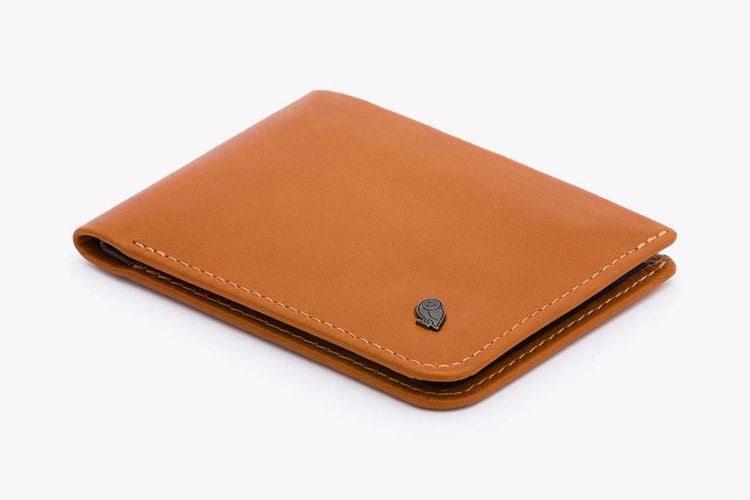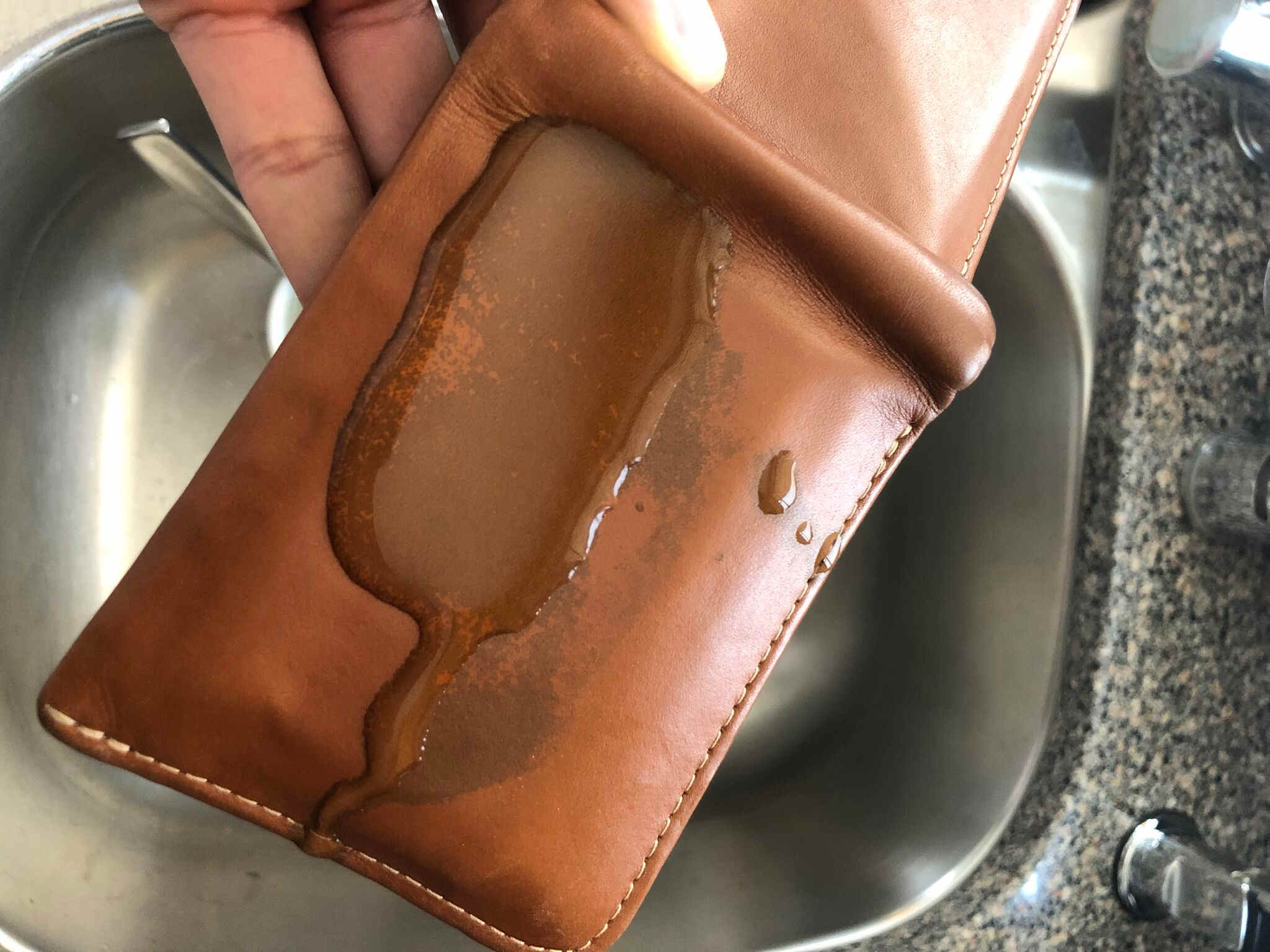
Introduction
A few months ago I was in the market for a new wallet. My sketchy looking $20 “leather” wallet from JC Penney that I had bought 5 years ago when I was 19 and broke was falling apart on me. This time I wanted to buy what I perceived to be a grown man’s wallet- so I started my search on Amazon. While the Bellroy Hide & Seek immediately caught my eye due to its slim profile, I wondered about the price tag. What goes into making a wallet like this?
Materials
Looking at the product description, Bellroy describes their Hide & Seek wallet as containing “Premium, environmentally certified leather”. Hm, understandably vague since this is only a product summary- but we’re going to have to dig deeper here.
There’s a section titled “Our Leathers & Materials” which seems promising. Expanding it we see this:
The leathers we use are premium hides tanned under gold-rated Leather Working Group environmental protocols, then dyed through so they age gracefully. The woven fabrics we use are sustainably produced and chosen for their durability and lightweight performance
Well this only opens up more questions, not all of them strictly related to materials. Who is the Leather Working Group? What does it take to conform to their gold-rated environmental protocol? How much does it cost to produce leather that abides by this protocol? Are “sustainably produced” fabrics more costly? By how much?
We’ll try to answer all of these eventually, but for now we’ll stick to finding out what kind of leather, fabrics and dyes are used. Scrolling to the site footer there’s a link to “Our Leathers”. I’m getting excited, will they tell us all about their process?
We use only premium grains selected exclusively from gold-rated Leather Working Group tanneries.
More of this Leather Working Group. Let’s look into those guys. According to their site, they seek
to improve the leather manufacturing industry by creating alignment on environmental priorities, bringing visibility to best practices and providing suggested guidelines for continual improvement” presumably by their leather working certification process and protocol.
The Leather Working Group lists tanneries and manufacturers that they’ve certified, but most of the tanneries didn’t have a website- and unsurprsingly when they did prices for their leather were not listed. Luckily, I found a blog post at Satchel & Page written by someone who claims to “talk to tanneries all the time” and has graciously shown us their price list. According to the sheet they provide us with, the full grain vegetable tanned leather that Bellroy supposedly uses costs $8.35 for 10-11oz, or about $0.76/oz. Since the blog post is from 2014, let’s adjust for 3 years of inflation using the BLS’ inflation calculator. Looks like we’d be at $0.80/oz today.
What about leather from a gold rated tannery specifically? Well since we couldn’t find any prices for that, we’ll have to grossly estimate. I imagine that the difference in price for sustainable and environmentally friendly leather would be somewhat akin to the price delta for sustainably farmed free-range chickens, or organic food of some type. Business Insider has already done the research for us, finding that organic chicken costs $2.99/pound whereas a normal chicken runs for $2.49/pound. That’s a 20% difference. Applying that to our $0.80/oz figure, we get $0.96/oz of leather.
The Bellroy Hide & Seek comes in at 1.8oz and is mostly leather, so we’re just going to blindly go with $0.96/oz * 1.8oz, giving us ~$1.73 in leather costs.
For the fabric which Bellroy says is “sustainably produced” and woven, I looked up the first retailer that popped up on Google for “sustainably produced woven fabrics” and landed at Honey Be Good. Their “Cirrus Solids” woven thread goes for $11/yard. I estimate that our little wallet has about 22.5 in. of thread around its perimeter, or 0.625 yards. Based on Honey Be Good’s pricing, we’ll put the fabric cost to be at ~$6.88.
Lastly the dye. Bellroy doesn’t say anything about the dyes that they use, but I gathered from a retailer called the The Cafe Racer that they use “non-toxic vegetable dye”. The first thing that came up on Google when I searched for “buy non toxic vegetable leather dye” was Fiebing’s LeatherColors™ at Michael’s, which goes for 6.99 for 2.2fl oz. So how much dye is needed to cover the wallet? I tested this by pouring 0.25 fl. oz. of water on one side of the wallet (don’t worry, it survived).

I didn’t spread the water out, but if I had’ve I could could’ve easily covered half of one folded side, or a quarter of the wallet.
The Hide & Seek’s product page says that the area of the wallet is 115mm x 85mm = 9,775 sq mm, so a quarter of that would be 2,443.75 sq mm. To get the coverage rate, we’ll divide 0.25 fl oz. by that number which leaves us with ~0.0001 fl.oz per sq mm.
Now we need to know the surface area of the entire wallet. It has 2 sides, so we’ll say that the surface area is about twice the 9,775 sq mm area, or 19,550 sq. mm. To find out how much dye this wallet needs, we’ll multiply its surface area by our coverage rate (19,550 sq mm. * 0.0001 fl.oz/sq.m). That gives us ~1.96 fl oz, or 89% of that 2.2fl oz bottle from Michael’s. So it looks like they’re using ~$6.22 in dye, 89% of the 6.99 price tag.
We’ll say that there are 3 primary materials, at these price points:
- Raw Vegetable Tanned Leather: $1.73
- Fabric: $6.88
- Dye: $6.22
Research and Development
Hiring designers and engineers to make a wallet probably isn’t cheap. Unfortunately nobody has stated how much they’re being paid by Bellroy on their Glassdoor. We’re going to have to dig deeper and estimate. I’m all about that. Looking at their open job positions, it looks like they’re hiring a “product development engineer”. Since they’re based out of Australia, let’s look up the going rates for that type of role out there. According to Payscale.com, an average product development engineer commands a $72k salary in Australian dollars. For an average product designer, Payscale says we can expect about a $79k salary. Bellroy doesn’t seem like an average type of company though- they’ve gone above and beyond to fetch quality leather and materials for their wallets, and their site looks pretty spiffy. It’s probably safe to assume that they don’t hire average people, so let’s throw a 10% markup on those salary numbers. That leaves us with $79.2k AUD for the engineer and $86.9k AUD for the designer. Now I’m American so I like things in terms of freedom dollars. It looks like as of the time of this posting, 1 US Dollar fetches 1.28 Aussie Dollars. So to sum things up,
1 Designer: $67.8k USD
1 Engineer: $61.8k USD
Now the question is, how many designers & engineers did it take to develop this wallet, how long?
Bellroy doesn’t publically releases numbers like this, but they did have a Medium post on a similar wallet, where they detailed the staff and time resources that went into designing it:
2 design leads, 2 support designers
1 product development manager
1 chief executive
1 chief financial officer
1 creative director
1 project manager
…
5 months of development
101 sold in the first day
We’ll only be looking at the design and engineering aspect of this. We’re going to flatten the roles here a bit, and assume that all 4 designers were paid $67.8k USD. We’ll also assume that the product development manager was paid the same as an engineer, which is $61.8k USD.
In total, we’re looking at (4 * $67.k + $61.8k) * (5 months/12 months) giving us $138,750.
Manufacturing
I tried to find information on how much it might cost to manufacture a leather wallet, but I unfortunately came up short. I did however, find this article on Hypebeast claiming that it costs $1-$2 to manufacture a T-shirt. T-shirts, leather wallets…what’s the difference, am I right? Let’s go with $3 for our factory, since I imagine that dealing with leather is at least 50% more involved than dealing with cotton and fabrics.
Licenses/Certifications
Going back to the Leather Working Group, it looks like to get the opportunity to be certified you need to pay them a membership fee. The fee structure looks like this:
0 - $250MM Net Sales - $2500/year.
We don’t know Bellroy’s net sales, but that same medium post mentioned that they sold 101 units of the “Coin Fold” wallet on the first day of production. This is unrealistic, but we’re going to assume that they sell the same amount on a daily basis, 365 days a year. At a $99.65 price point, that’s $3,673,597/year. Even accross 90 different product offerings at a variety of price points, I doubt that they clear $250MM a year in net sales. This site estimates that they do $2.871MM in revenue, but I’m not sure how much that’s to believed as their information looks outdated.
In any case, let’s go with $2,500/year for the Leather Working Group membership. This cost is spread across multiple products (about 90), so let’s say ~$28.80 per product as a one time cost.
Estimated Profit Margin
| Component | Cost |
|---|---|
| Leather | $1.73 |
| Fabric | $6.88 |
| Dye | $6.22 |
| Manufacturing | $3 |
| Total Cost | $17.83 |
With the MSRP price on Bellroy’s site being $89.95 and the estimated cost to make each wallet being only $17.83, I’ll guess that Bellroy is pocketing $72.12 per wallet. That’s a 400% profit margin! Assuming these estimates are correct, of course.
With licensing and R&D costs, how many wallets would have to be sold to recoupe their costs? ($28 one time LWG fee + $138,750 R&D staff costs) / $72.12 profit/wallet = ~1,924 wallets. If they sell wallets at a rate of 101/day as we assumed, then it only takes them 20 days to break even. Not bad.
Wrap Up
If my estimates are anywhere close to correct, 400% is more than a healthy profit margin. It’d be great to hear from the Bellroy team to know if I got anywhere near to the actual cost of making this thing.
Hope you enjoyed this first write up! My aim is to post 1 article at the start of each week. I’ll be looking to analyze more obscure or strange products, so if you guys have anything suggestions for things you want to see a write up on email me at pricetaganalysis@gmail.com
Lastly, I’m not at all affiliated with Bellroy, but if you’re in the market for a new wallet, I’m enjoying the Hide & Seek quite a bit and can definitely recommend it. You can get it from Amazon here.
Thanks for reading!
P.S. If you work in the leather working industry and want to tear me up about how terrible my estimations are, feel free to post a better estimation in the comments.